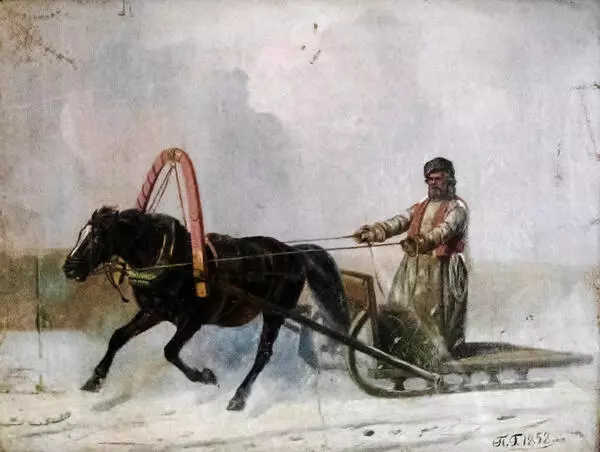Artist Pyotr Nikolaevich GruzInsky (1837–1892) was born into a family of a poor lord of the manor in Kursk. He began his creative career by practicing painting on his own in his parental home. In 1851, he enrolled in the battle painting class at the Academy of Arts, where he was mentored by BogdAn WillewAlde, a student of Karl Bryullov and a distinguished professor of battle painting. Pyotr completed his studies at the Academy eleven years later. For his painting ‘The Capture of GunIb in the Caucasus in 1859,’ Gruzinsky was awarded a Great Gold Medal, the title of the first-degree artist, and a scholarship to travel to Paris.
In this case, the word ‘pensioner’ has nothing to do with age. In the Russian Empire, this was what they called the graduates of the Imperial Academy of Arts who received a government allowance (pension) for further improvement of their skills between the 18th and the early 20th century. In modern terms, this could be called a grant. Only the best of the best could become pensioners, with most of them being winners of the Great Gold Medal of the Academy of Arts. Pyotr Gruzinsky was one of such pensioners.
The artist traveled extensively during his pension period, visiting Italy, Germany, Austria, and, in 1865, the Caucasus.
An excellent battle and animal painter, Gruzinsky authored numerous genre paintings and at times turned to landscape painting. His works were in high regard and were exhibited not only in Russia, but also abroad. He received commissions from the royal family and the imperial court.
Especially standing out among the works of Pyotr Gruzinsky are small genre paintings that feature horses harnessed to a cart or a sleigh as their main subject. ‘A Three-Horse Sleigh’ belongs to an early period of the artist’s career. It is an oil painting created approximately in the mid-19th century.
It depicts three horses harnessed to a sleigh and rushing down the road, with three replacement horses following close behind.
There are two men in dark clothes sitting in the sleigh. The whole scene is immersed in the bluish gray colors and pinkish shades of a winter evening. The simplified environment of the landscape emphasizes the theme of the road and movement.
Russian troika is the only method of harnessing three horses of different gait in the world. The forehorse (the central, strongest, and largest horse) is supposed to move in an extended trot, while the trace horses gallop. The trace horses sort of support the forehorse, allowing it to maintain the necessary pace for long periods of time. This harnessing method allows all three horses to go longer without getting tired. Unharnessed replacement horses made it possible to travel greater distances. The speed of a classic Russian troika can reach up to 50 kilometers per hour.
In this case, the word ‘pensioner’ has nothing to do with age. In the Russian Empire, this was what they called the graduates of the Imperial Academy of Arts who received a government allowance (pension) for further improvement of their skills between the 18th and the early 20th century. In modern terms, this could be called a grant. Only the best of the best could become pensioners, with most of them being winners of the Great Gold Medal of the Academy of Arts. Pyotr Gruzinsky was one of such pensioners.
The artist traveled extensively during his pension period, visiting Italy, Germany, Austria, and, in 1865, the Caucasus.
An excellent battle and animal painter, Gruzinsky authored numerous genre paintings and at times turned to landscape painting. His works were in high regard and were exhibited not only in Russia, but also abroad. He received commissions from the royal family and the imperial court.
Especially standing out among the works of Pyotr Gruzinsky are small genre paintings that feature horses harnessed to a cart or a sleigh as their main subject. ‘A Three-Horse Sleigh’ belongs to an early period of the artist’s career. It is an oil painting created approximately in the mid-19th century.
It depicts three horses harnessed to a sleigh and rushing down the road, with three replacement horses following close behind.
There are two men in dark clothes sitting in the sleigh. The whole scene is immersed in the bluish gray colors and pinkish shades of a winter evening. The simplified environment of the landscape emphasizes the theme of the road and movement.
Russian troika is the only method of harnessing three horses of different gait in the world. The forehorse (the central, strongest, and largest horse) is supposed to move in an extended trot, while the trace horses gallop. The trace horses sort of support the forehorse, allowing it to maintain the necessary pace for long periods of time. This harnessing method allows all three horses to go longer without getting tired. Unharnessed replacement horses made it possible to travel greater distances. The speed of a classic Russian troika can reach up to 50 kilometers per hour.




